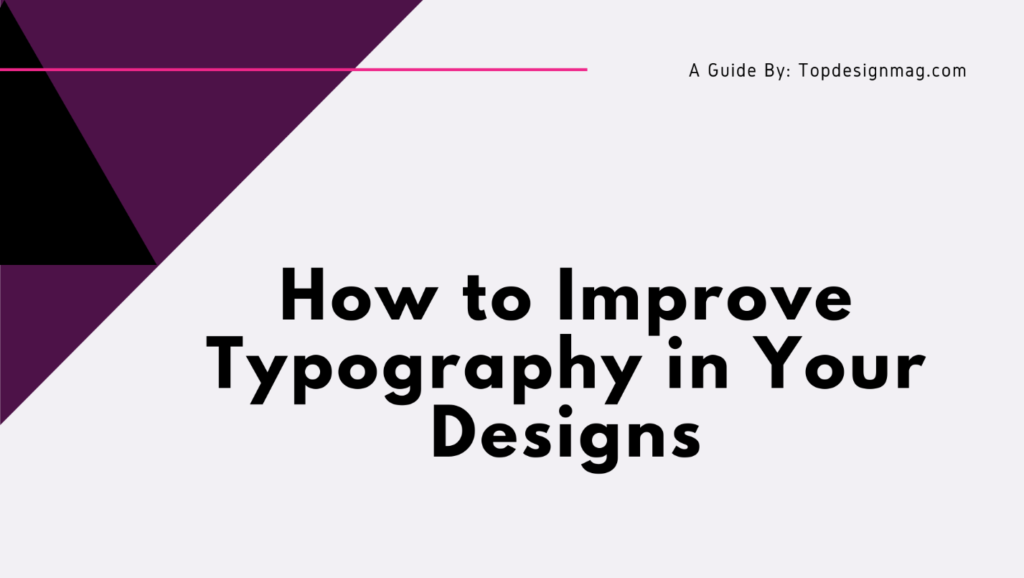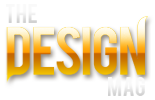How to Improve Typography in Your Designs
When people make brochures of events or parties, they pay attention to the design of the brochure. They make the typeface noticeable, the size of the font larger, and the colors bright.
When it comes to typography, most people think that setting a typeface and font size is enough. However, typography is much more than that, and if someone is practicing it, then there are some important points they can’t ignore.
If they know how to make their typography design better, then this gives them more control over their message. If the message of the text and the typography match each other, then you have successfully grabbed the attention of the reader.
For those who don’t know what typography is, it is simply an artistic technique of arranging type or text. The designers pay extra attention to the typeface and font, but if they learn some more things about typography, they can do better in sending a message to the reader.

Measure of Characters
When you are making a poster, for example, you have to make sure that the length of the main line is short. If a line is long, then that can be very distracting for the reader.
For example, if it is a Halloween poster, then the typography expert would write ‘Creepy Haunted House’, instead of ‘Welcome to the haunted house, which is creepy’.
You want to assure optimum readability which is why the characters in a line should be between 40-80. In most designs, 65 characters are considered the ideal way to improve typography. In simple words, make your message short and sweet.
Choosing The Right Font
Fonts are the most important thing when it comes to improve typography in your designs. As fonts can change the appearance of your design. If you are desining a professional graphic design and choose wrong fonts then they will distory the appearance of whole design that’s why choosing a right font is very important for your design.
There are number of fonts available out there and as you know each font has its own design and you will get a different look by usig it but as per our analysis we have fount the futura font is one of the leading font in design industry. It’s one of the most used font out there and has been already used by many graphic designers.
If you are going to design a professional brochure or mockup then you should also give a try to this font.
Leading
This is another way to improve typography. When you write a paragraph or a short message, make sure to leave space between the lines. If there is no space between the lines, then it will be difficult for the reader to focus on them. Moreover, leaving space between lines, improves the appearance of the message.
The factors that affect leading are type size, weight, measure and word spacing. If the measure is long, then you need to leave more space between lines. If the type size is larger, then not much leading is required. A good tip here is that, if you set leader twice more than the type size, then that would look appealing. However, this depends on the typeface as well.
Content’s Mood
You must have noticed how some notices have the same typeface. For example, the typeface of coffee houses is the same; they use the typeface which people see often, so they are able to recognize the nature of the place. Every typeface in typography has its own personality, and that has to match the mood.
The biggest mistake a person can make, when it comes to typography, is that one size and typeface can fit all. Choosing a typeface gives an individual the chance to decide, what they want to deliver through their design. When a reader is reading a message, the typeface sets a mood and impacts how the reader absorbs and process information.
Hierarchy of the Design
Like every organization has its hierarchy, typography design also has a hierarchy. It is important for individuals to follow a well organized design, because it will make it easier for the reader to navigate the page they are reading. Whether it is a magazine, or a newsletter, there is a basic hierarchical design that each has to follow.
There are five things that you need to focus on when it comes to hierarchy; creativity, proficiency, usability reliability and functionality. In creativity, you are supposed to show the aesthetic beauty to the reader, and interact with them. In proficiency, the individual has to do better, by designing something of a high level.
When it comes to usability, the reader should be able to use the design of the typography, easily. The reliability of the hierarchy of needs means a stable and consistent performance design of the typography and in functionality, the typography meets the basic functional needs of the design.
Thus, it is best to reach the creativity level. At this level, quality typography is produced and the individual is able to share the aesthetic beauty of the design with the user.
For example, when magazine issues are released for the public, the information is prioritized according to its importance. Each piece of information has a different text size. The structure has to be easy so that the reader can scan it easily; for example, putting headings and subheadings.
Vertical Rhythm
If your work has continuous flow and rhythm, only then will it make sense to the reader. Designers use the baseline grid as the foundation, and then follow the exact same pattern throughout. If there is a continuous rhythm, then it makes the content more readable. Here, the text has to be balanced, of equal size and measure. If you have paragraphs, then make sure that they have the same measures.
Spacing & Alignment
If your typography doesn’t have good details, then it won’t appeal to the audience. There are two elements which are very important for typography design; spacing and alignment. If there is no spacing and alignment, then the text will look cluttered and oddly designed.
If you want to save space in designs, then you have to decrease tracking, which is not the same as the margin. The blank space around the edges of a page has an impact on the text. However, make sure that you use the white space appropriately, and it doesn’t send a wrong message to the reader. If a page doesn’t have balanced white space, then it will be really hard for readers to read a page, as it will appear to be cluttered.
For example, if you want to place a logo on the top of a page, then you need to leave white space around it. This way, the reader will know that there is a logo on top, and it will be easier for him to concentrate. This type of typography design can be seen in business cards and at the marketplace.
Kern
Kerning is different from tracking. While tracking is about leaving white space around the text, kerning is the space between letter and characters. However, most people don’t focus on this aspect of typography, which is why they face problems in getting the attention of readers. When you are using large and visible typography, for newspaper headlines, then you need to check the headline visually. There should be cohesion between the letter of the headline so that they stand out.
Typos
The one mistake that most typography individuals make is that, they stretch words and letters too much. It is alright to think that they need to fit in a space, but if you stretch them too much, then they lose their appeal. It is best not to use any fake italic, in case the font doesn’t have an italic style. Moreover, after you are done, check the spellings and grammar of your text.
Typography involves making text more presentable and appealing. If you are using the wrong spellings and grammar, then nobody is going to care about the design.
Background Color
Now that you have learned about improving typography by focusing on the typeface, the next thing you need to do is learn about colors. Have you ever seen a restaurant billboard? When you do notice them next time, observe how they have used colors. The background color and the text color can’t be mismatched, because they won’t give an appealing look to the reader. For example, the background color and the text color that McDonald’s use, is very eye catching.
Make sure that you don’t use clashing colors. If you want your text to become noticeable, it is not necessary to use neon colors. Neon colors should not be used without any purpose, because they often come across as striking colors and don’t appeal to everyone. Moreover, make sure that your background is not too busy, because that can be very frustrating for the reader. You can use warping and transparency effects on your background, as they are fun text treatments.
Observation Skills
It is alright to look at other typography designs, and then decide what you should do. There are so many typography designs on the internet, that you can get inspiration very easily. If you are opening a coffee shop, for example, then make note of the common use typography designs. When you use a commonly used design, then customers notice you right away. This is because, the typography design for coffee houses is similar, and it is fixed in the mind of customers.
One Typeface
It can be very appealing to use two typefaces in a single layout. However, this may confuse the reader and it will clutter the page as well. Don’t use two typefaces of the same classification, like using sans serif and slab serif together. This is because, they won’t create a contrast, and will appear to be very odd. This is a great way of improving your typography skills; just focus on one typeface, until you understand all of them.
Double Point Size
This point is something most people don’t consider, and it is the size of the typeface you are using. If you have headings on your paper, followed by body paragraphs, then it is best to use a double on headings. For example, if the size of your heading is 30, then the size of your paragraph’s text would be 15.
Group Blocks
This is not the same as building a hierarchy of your page. This is about creating a group of related information, because that would make a magazine or newspapers appear more orderly. You can use lines to further classify information, like dividing a page into two columns or rows.
Corners of a page
You might be tempted to place text in the corner of a page, but that doesn’t improve readability. Don’t put any sort of notes on the edge or comers, because that is negative space. Negative space is a good thing, because it lets the design you have chosen for your page, breathe properly.
Widows and Orphans
This is a typography design mistake that most people make. A widow is a short line or a single word, which you often place at the beginning of a column or at the end. This happens because of lack of space, but it looks very odd on a page, and doesn’t create a good appeal. It is best to finish lines properly, and if a word is remaining, then you need to paraphrase. To avoid such a problem, you also need to learn about leading and measuring.
Emphasis
If you want to place emphasis on some specific words, then you can do so without any interruption. It is best to italicize a word if you want the reader to focus on it. However, people can also bold a letter or use uppercase, so that the word becomes more prominent. However, don’t do two things at the same time, like bold and caps, because that will make the word look very clumsy and disruptive.
Practicing Handwriting
You must be wondering as to why you need to practice handwriting when you can simply use digital means to write something. However, if your handwriting is good, then you can make unique things by giving them a personal touch. Imagine a digital headline and a headline made with calligraphy writing. Both headings will have a different impacts, and you can even scan your headline if you want.
There are many ways through which you can improve your typography design. Typography is a skill, and it is not just limited to the type and font size; it is much more than that. If you want to do typography, then it is best to learn about it first. You can take an online course, watch online tutorials, or take an actual class. This way, you will be able to learn about the most commonly used fonts and how you can be good at typography.



